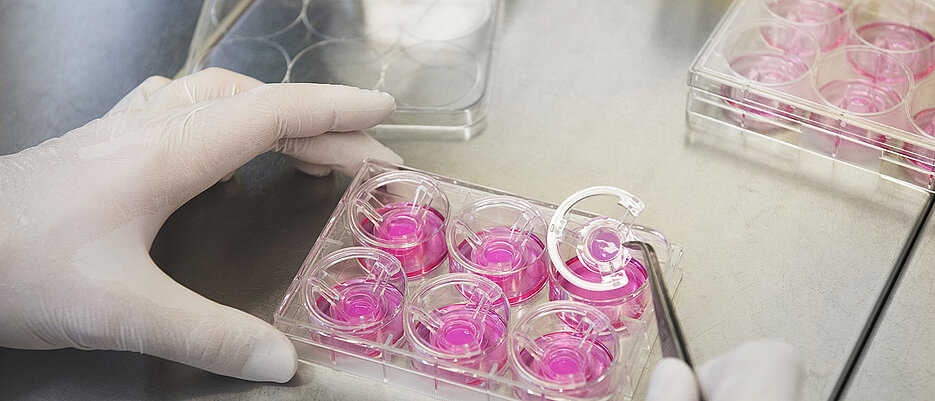Coronavirus: rapid drug testing
04/08/2020A Würzburg research group uses tissue models of the human respiratory mucosa to identify drugs to treat the novel coronavirus.
To curb the pandemic caused by the novel coronavirus SARS-CoV-2, unprecedented restrictions have been imposed on public life and the economy. Researchers around the world are working flat out to fill the knowledge gaps about the new pathogen and develop effective treatments.
Such activities are also underway in Würzburg: Researchers at the Fraunhofer Translational Center for Regenerative Therapies (TLC-RT) have joined forces with Professor Jochen Bodem, a virologist at the University of Würzburg, to single out substances that work against the virus using special tissue models.
Using organoids of the respiratory mucosa
The tissue models of the TLC-RT are nothing special to look at: clear multiwell plates holding cell culture scaffolds in a light pink nutrient solution.
The technology behind this unexciting setup, however, could revolutionise the development of active substances and drugs. The inconspicuous looking scaffolds are used to cultivate entire tissue models typical of organs – i.e. not just individual cells of the digestive tract but intestinal organoids containing all essential cells of the intestinal mucosa, or not just single cells from the respiratory tract but a cell model of the human respiratory mucosa which is the primary target tissue of the SARS-CoV-2 virus.
Rapid drug testing with tissue models
The Fraunhofer team and Bodem's group are currently examining defined substances for their effectiveness against SARS-CoV-2. "We analyse whether the addition of certain substances can inhibit viral replication in the tissue models. Moreover, we study how an infection with SARS-CoV-2 affects the functionality – for example the barrier function or mucus production – of respiratory tract models. These airway tissue models thus provide a comprehensive picture of the processes that are likely to take place in the human body following infection," says project leader Dr. Maria Steinke from the TLC-RT. "In a first step, it would already be helpful to find substances that weaken the virus and strengthen and stabilise the body's own immune defences."
The tissue models can also serve to test drugs that are already approved for other diseases. The research groups hope that this will enable them to identify drugs to treat SARS-CoV-2 as quickly as possible because it would allow cutting short the long and complex drug approval processes that are usually mandatory.
Research approach for specific early warning test
Early warning tests that reliably detect SARS-CoV-2 at a very early stage of the infection could be another tool in the fight against the coronavirus pandemic.
"The fact that people who have contracted the virus frequently report gastrointestinal complaints at a relatively early stage of the infection could be useful in this respect. It is still unclear whether and how this is related to the coronavirus. But our model systems for the gastrointestinal tract, for example, could be used to ascertain this," adds PD Dr. Marco Metzger, the Director of the Fraunhofer TLC-RT. A number of project applications have been submitted to the Federal Ministry of Education and Research (BMFB) and the German Research Foundation (DFG) together with cooperation partners from Würzburg and Leipzig to obtain further funding for these activities.
Reliable data with fewer animal experiments
The research groups of the TLC-RT are at the forefront of biomedical research with their human 3D tissue models.
"We use these cell-based models, for example, to test active substances, drugs or cosmetics for research and industry. This reduces the number of animal experiments considerably and the test results can be transferred more reliably to humans because we can use human cells from cell banks for the test models," explains Professor Gerhard Sextl, the Director of the Fraunhofer Institute for Silicate Research (ISC) in Würzburg, which the TLC-RT joined in 2017.
The models are particularly interesting for the preclinical phase of medical drug development which is all about identifying the correct substances to target the respective disease quickly and reliably. Here, the researchers want to use alternatives to animal experiments or the highly simplified 2D cell culture systems that are still predominantly used.
Contact
Marie-Luise Righi, Fraunhofer Institute for Silicate Research ISC, Head of PR and Communications, T +49 931 4100-150, righi@isc.fraunhofer.de
Web link







